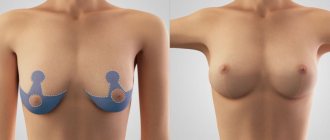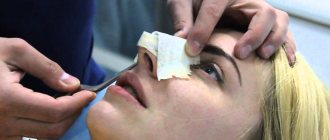The debate about the need for mammoplasty has not subsided for a long time. Many people dream of enlarging their breasts, some dream of reducing them; in some situations there are medical indications. However, it is difficult to deny the facts confirming that correction of appearance allows millions of women to get rid of the discomfort pressing on them. The decision to consult a surgeon is often difficult, since fear of the operation, the possibility of complications, and the discrepancy between the results obtained and the expected ones stops the choice. Such concerns are normal, especially since abdominal swelling after mammoplasty is a common complication that manifests itself during the rehabilitation period.
Why does swelling of the abdomen and chest appear?
The appearance of edema after mammoplasty is considered normal. This is explained by the fact that the body reacts in this way to the appearance of a foreign body. Swelling may be accompanied by discomfort and pain.
Given that each body reacts to surgery individually, the degree of swelling and the time it takes for it to subside varies.
In most cases, swelling is observed only in the chest area.
However, some patients experience abdominal swelling. This is also a normal reaction of the body. This indicates that the fluid does not accumulate in one place, but spreads throughout other tissues.
When does abdominal swelling go away? In about 3-4 weeks. There are factors that contribute to increased swelling in the chest area after surgery, these include :
- Thermal procedures. You can provoke swelling by visiting a bathhouse, sauna, solarium, or simply lying in a hot bath.
- Physical activity for the first 5-7 days after surgery. Considering that after mammoplasty it is not recommended to even raise your arms or make any other movements that affect the breast muscles, even slight physical activity can increase swelling.
- Intimate life. Sexual contacts should be excluded for the 30-day period after surgery, since during arousal, blood begins to actively circulate in the mammary glands.
- Increased body temperature. If fever appears after surgery, you must take the necessary measures as soon as possible to maintain body temperature at a normal level.
If after 3 days the fever does not subside, then this indicates the appearance of an inflammatory process in the body and immediate medical attention is required. - Incorrect body position during sleep. It is forbidden to sleep on your stomach and horizontally on your back. You can only sleep in a semi-sitting position.
- Compression. After surgery, you must wear compression garments without removing them at night for 30 days.
- Alcohol and blood thinning medications. In such a situation, there is a risk of bleeding.
In extremely rare cases, severe breast swelling after surgery occurs due to an unsuitable implant or a surgeon error during the operation.
What does abdominal swelling look like after mammoplasty?
According to experts, swelling is a logical reaction of the body to surgery, but it may not appear immediately after surgery.
Outwardly, it looks like a swelling in a certain place, with stretched skin and an unnatural shine. When the rehabilitation process proceeds normally, the swelling goes away without additional impact on the affected area after several weeks.
Doctors identify a number of reasons that can contribute to the appearance of swelling and the development of pathologies:
- refusal of recommended compression garments;
- unreasonable physical activity;
- visit to the bathhouse, sauna;
- sexual activity;
- long water procedures;
- exposure to ultraviolet rays (on the beach, in the solarium).
First of all, the chest swells, then the swelling gradually goes down. Some women compare the pathology to a pregnant belly. Its surface becomes as if inflated, dense to the touch. If you press, there will be depressions in the skin where your fingers used to be.
Skin color does not change with swelling. However, if there is bleeding, hematomas can also descend into the abdominal area. Many of the surgeon's patients note that the bruises move along the surface of the abdomen. It depends on the activity of the woman’s lifestyle
Postoperative edema should be distinguished from flatulence. In this case, the cause of bloating is excess gas formation in the intestines. This condition can result from the use of anesthesia or painkillers. In such a situation, the best solution would be a diet, medications prescribed by a doctor, and folk remedies.
Photos before and after surgery
In the following photo you will see what the breasts look like before and after surgery.
Is it dangerous?
Despite the fact that swelling after mammoplasty is normal and does not pose any danger to health, there are situations when you should consult a doctor. If the following symptoms appear, breast swelling after surgery poses a threat to the patient’s health:
- change in skin color or appearance of a rash, blueness, redness;
- the appearance of local compactions;
- swelling continues to increase even after 7 days of rehabilitation;
- there is purulent discharge in the surgical sutures;
- body temperature rises;
- chills appear;
- a burning sensation is felt in the chest after a 7-day rehabilitation period.
If at least one of the above signs appears after mammoplasty, you should immediately seek help from a doctor.
Why is this happening?
Swelling of the arm after breast removal occurs due to the fact that lymph nodes and vessels are partially removed during the operation.
Normally, lymph should constantly flow out of the soft tissues, but when the number of vessels decreases, the outflow of lymph also becomes worse. Swelling of the arm after removal of the mammary gland requires mandatory treatment. If the process is left unattended and the start of therapy is delayed, the swelling will progress. An increase in the volume of one arm, constant discomfort, and increased swelling will significantly reduce the quality of life.
When does it go away, how many days does it last after breast augmentation?
Complications after surgery appear both in the early and late stages , i.e. in the first 14 days or after several months. Breast swelling appears early in the rehabilitation period. On days 3-4, swelling becomes more and more pronounced and spreads to the chest and even the abdomen.
When will the abdominal swelling go down after breast augmentation?
How quickly the swelling goes away depends on the complexity of the operation and the individual characteristics of the patient’s body. This condition can last up to 2-2.5 months.
You can learn more about what the consequences of mammoplasty can be, as well as see photos before and after breast augmentation surgery here.
Is it possible to remove it and how to remove it?
Breast swelling, although a normal phenomenon, is uncomfortable and not very pleasant. To relieve swelling, you can use the methods described below. It is recommended to first consult with the doctor who performed the operation.
Massage
Massaging to get rid of swelling after surgery is allowed only after 7 days of the rehabilitation period. Doing a massage yourself is strictly prohibited.
For the procedure, you should contact the clinic where the operation was performed. A light breast massage should only be performed by a specialist.
Cold compress
You can apply a cold compress to your chest yourself.
To do this, use either ready-made compresses or bandages, or those made at home. You will need to wrap several ice cubes in a small piece of cloth or gauze. If you don’t have ice cubes, you can use frozen foods, also wrapping them in a cloth first. You need to apply the compress to your chest as carefully as possible.
The duration of the procedure should not exceed 15 minutes. During the procedure, you need to remove the compress when the cold in the mammary glands becomes pronounced, and then apply it again.
The right underwear
It is prohibited to walk without compression underwear for the first month after surgery. Special underwear can be purchased at the clinic or provided after surgery.
A medical bra is made according to special requirements for the shape, size and fabric of the product. With the help of compression garments, the breasts are maintained in an ideal position, which prevents disruption of blood flow to the glands.
Read more about how to wear compression garments after mammoplasty, as well as the rules for caring for them, here.
Diet
As for your daily diet, you should avoid using salt and highly salted foods as much as possible , for example, dried fish. At the same time, it is necessary to comply with the drinking regime. This is necessary to flush salts from the body and prevent fluid retention in the tissues.
Diuretics
Diuretic drugs or herbal remedies will help quickly remove swelling. Drugs that have a diuretic effect remove excess fluid from the body.
A specific remedy should only be selected after consulting a doctor. It helps a lot in this situation:
- chamomile tea;
- lingonberry juice;
- cranberry juice.
What diseases cause benign edema?
Inflammatory disease of the mammary gland is benign in outcome, with or without consequences, but sooner or later it ends safely. In young women, unilateral swelling of the gland occurs with infected lactostasis resulting in mastitis; bilateral, very unexpressed fluid retention is caused by taking hormonal contraceptives.
In adulthood, unexpressed and asymmetrical fluid retention, mainly in superficial tissues, is caused by fibrocystic mastopathy and hormonal imbalance due to diseases of the reproductive organs.
It is possible to develop erysipelas of the chest wall involving the mammary gland due to the activation of bacterial microflora, when within a few hours the skin swells and becomes brightly colored, the retention of a large amount of fluid deforms the organ and causes severe pain.
In life, everything is possible, and young women are diagnosed with senile diseases, and mature women are diagnosed with youthful pathologies unusual for their age. For an adequate diagnosis, a mammologist must have extensive and varied clinical experience; it is precisely such a specialist who receives consultations at the international clinic Medica24.
We will call you back, leave your phone number
Message sent!
expect a call, we will contact you shortly
How to fight if it doesn’t go away?
After breast surgery, you need to undergo regular examination by a doctor who will monitor the condition of the mammary glands. If the swelling does not go away, then you do not need to take any measures yourself. The doctor should do everything.
In cases where swelling does not subside for a long time, drainage is used. It is used to remove liquid accumulated in the area of the seams. The method is the most effective for quickly removing swelling.
Before you decide to undergo surgery to correct the shape of your breasts, we recommend that you read our articles about what reduction and augmentation mammoplasty are, how breast lifting and enlargement surgery, correction of nipples and areolas are performed, and how to understand that the plastic surgery was unsuccessful and what types of stitches are there and how long it takes to heal.
Exercise therapy after mastectomy
One of the effective ways to eliminate swelling after breast removal is gymnastics. This improves blood circulation in the area where the operation was performed and accelerates the formation of new lymph flow paths. It also helps to relax the muscles of the arm and shoulder.
- sit down, put your hands on your knees. Turn your hands from the palm to the back and back. Clench and unclench your fist.
- bend your elbows, place your palms on your shoulders. Raise your elbows in front of you, then return to the starting position.
- muscle relaxation exercise: lean towards the operated chest. Rock your hand back and forth. If both mammary glands are removed, then the exercise is done separately for each arm.
- perform circular movements in the shoulder joints, changing direction.
- move your hands behind your back, connect your fingers. Raise your hands behind you, squeezing your shoulder blades together.
Hand exercises after mastectomy are recommended to be combined with massage. You can do it at home, repeating it several times a day. To do this, the arm on the side where the mammary gland was removed must be extended upward and rested on the wall. With stroking, but at the same time tangible movements, you need to massage your arm from the elbow to the shoulder, and then from the fingers to the shoulder. The duration of one massage session is about 5 minutes.











